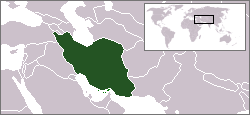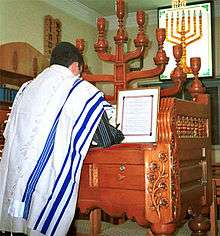Jews of Iran (film)
| Jews of Iran | |
|---|---|
 | |
| Directed by | Ramin Farahani |
| Produced by | Ramin Farahani |
| Edited by | Ramin Farahani and Hamidreza Fard |
Release dates | 2005 |
Running time | 52 min. |
| Country | Netherlands |
| Language | Persian with English subtitles and narration |
Jews of Iran is a 2005 documentary film by Iranian-Dutch filmmaker Ramin Farahani. The film examines the lives of Persian Jews living in Iran's predominately Islamic society. Although they face discrimination, they choose to remain in their homeland rather than flee the country.
The documentary breaks ground as the first film to cover this subject, capturing both friendships among Muslims and Jews and the prejudices against the Jewish minority. Farahani states that Jews of Iran is meant to "help westerners correct their image" of the Middle East and allow them to "see the nuances" within the culture.[1]
Synopsis
With the background of Middle Eastern music, the film offers shots of century-old architecture and travels through Tehran, Isfahan and Shiraz. A broad range of Jewish Iranians are interviewed, from an old woman in a hospital to a bright computer science student.
Although Jews have lived in Iran for 2,700 years, the 1979 Iranian Revolution pressured most Jews to leave the country. In modern Iran, rampant antisemitism continues to threaten the remaining citizens.

"They’re very open with their insults," says a young Jewish girl exposed to prejudice in Iran. Regarding her treatment by Iranians: "They say we're impure — we're filthy."
Deep-rooted antisemitism is revealed when a beautiful Muslim art student is asked if she has any Jewish friends: she couples her negative response with a coy giggle, claiming that it is "because of the atmosphere Israel has created" that she is not fond of the Jews. When confronted with the point that the Jews in Iran are not Israelis, she simplifies her argument, offering a big smile and saying, "I don't know...They don't mix with us either. Never."
Religious tolerance is also portrayed. In one scene, two mothers, one Jewish and the other Muslim, have been friends since college. Both have raised sons that are now equally as close. The woman laugh about religious prejudice, and the Muslim boy explains his friend's Kosher diet by saying, "It's his choice. He eats what he wants." When asked, the boys admit that they don't really talk about religion; they listen to the same music, attend the same parties, and lazily lounge around each other's homes.
The two cultures also overlap and feed off each other. In Isfahan, Jewish artist Soleiman Sassoon's work is strongly influenced by Iranian art and Islamic architecture. Pointing to his paintings, he explains how he naturally blends religious motifs, such as the Ten Commandments and David's prayer, with a traditional Iranian art style.
Finally, Farahani travels to Shiraz, where thirteen Jews have been accused of espionage. The evidence against them is circumstantial and built on extorted confessions, leading to the belief that the initial accusations were concocted. Nonetheless, they face death sentences, receiving 2-9 year prison terms.

Reception
In an interview, Farahani said, "The reaction of Jews and Iranians outside was mainly emotional because they got more feeling with the things we show in the film...I heard of wet eyes, nostalgic feelings for missing roots etc."[1] Harif of The Association of Jews from the Middle East and North Africa wrote that the film gives, "A rare glimpse into the lives of some of the 25,000 Jews still in Iran...and gives a remarkable insight into the official discrimination suffered by the Jews under the Islamic regime."[2]
Similar movies
- In Search of Happiness
- Reconstruction
- Next Year in Argentina
- Queen of the Mountain
See also
- History of the Jews in Iran
- International Conference to Review the Global Vision of the Holocaust
- International Holocaust Cartoon Competition
- Iran–Israel relations
- Mahmoud Ahmadinejad and Israel
- Persian Jews
- Shiraz blood libel
References
- 1 2 Jandaghian, Shohreh (2006). "First Documentary Film about Persian-Jews in Iran". Digital Journal Online. Retrieved July 23. Check date values in:
|access-date=(help) - ↑ "Jews of Iran". Harif, Association of Jews from the Middle East and North Africa. 2005. Retrieved 23 July. Check date values in:
|access-date=(help)
External links
- "Jews of Iran" on director's homepage: Interviews and articles listed
- DVD of "Jews of Iran" on director's weblog
- Shohreh Jandaghian's interview with Ramin Farahani
- Jewish World interview with Ramin Farahani
- Banned Documentary Sparks Oxford Discussion on Iranian Jews